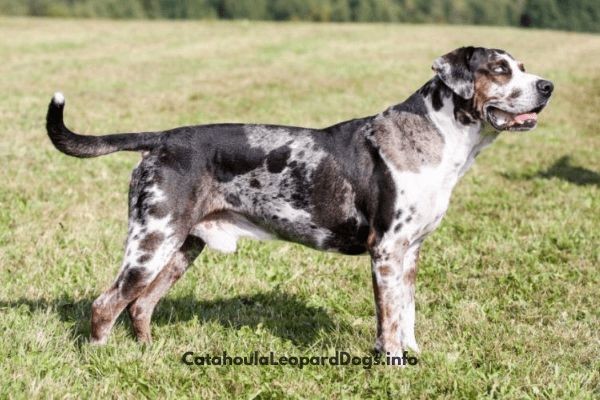
The Labahoula, a cross between the Labrador Retriever and Louisiana Catahoula Leopard Dog, represents a unique hybrid that combines the best traits of both parent breeds. First bred in the 1980s, these medium to large dogs typically stand 20-26 inches tall and weigh 55-95 pounds, with a lifespan of 10-14 years. Known for their intelligence, athleticism, and loyalty, Labahoulas inherit the Lab's friendly temperament and the Catahoula's strong work ethic. While primarily bred as working dogs, they can make excellent family companions when provided adequate exercise, training, and socialization. Their distinctive appearance often features the Catahoula's striking coat patterns combined with the Lab's sturdy build.
Hunting and Working Traits
Natural Instincts
The Labahoula inherits strong hunting and working instincts from both parent breeds. While Catahoula Leopard Dogs were historically used for herding and hunting wild boar, the Labrador excels at retrieving game. This mix results in a versatile working dog with natural abilities for tasks like search and rescue, therapy work, and service roles. Their high prey drive means they may chase after animals, so proper containment and training are essential.
Performance Capabilities
These athletic dogs can work effectively by 10 months of age, though they don't fully mature until age 2. They demonstrate excellent swimming abilities and thrive in activities like agility, obedience, and scent work. The Labahoula's intelligence and physical stamina allow them to excel in bird and game hunting as well as competitive dog sports. However, care must be taken not to overwork young dogs before full maturity. Their natural athleticism makes them ideal partners for hunters and trainers looking for a capable working companion.
Catahoula Lab Mix Appearance & Physical Traits
Size and Structure
The Labahoula is a medium to large-sized dog, with adults typically standing 20-26 inches tall at the shoulder and weighing between 55-95 pounds. Males tend to be noticeably larger than females. Their muscular, athletic build combines the sturdy frame of the Labrador with the agile, powerful structure of the Catahoula, resulting in a well-balanced working dog physique.
Coat and Coloring
This mix usually has a short to medium-length coat that can be either single or double-layered. One of their most distinctive features is the potential for merle patterning and striking eye colors, including blue, green, or multi-colored irises due to heterochromia inherited from the Catahoula parent. Their coat colors vary widely, including black, tan, yellow, leopard spotted, tricolor, or patchwork patterns. Unlike solid-colored Labs, Labahoulas often display unique spotted or mottled markings characteristic of the Catahoula heritage.
Training & Exercise Requirements
Training Approach
While the previous sections covered general traits and abilities, this section focuses specifically on effective training methods. These dogs require firm guidance and early socialization, responding best to positive reinforcement techniques. Training should start early to prevent destructive behaviors, with a focus on basic obedience, recall commands, and proper socialization. The Labahoula's high intelligence means they can learn quickly, but their independent nature from the Catahoula parent may lead to occasional stubbornness. Without proper training and mental stimulation, they can become destructive in the home.
Exercise Intensity
Unlike previous sections that discussed general exercise needs, this section details specific exercise requirements and intensity levels. These high-energy dogs need at least 30-60 minutes of moderate to high-intensity exercise daily. Activities should include:
- Multiple long walks
- Off-leash running in fenced areas
- Swimming sessions
- Interactive play sessions
Without the proper amount of exercise and attention, they will start causing trouble by digging holes and chewing things. The exercise routine should be varied to provide both physical exertion and mental engagement. Combining training with exercise through activities like agility courses or retrieving games helps satisfy both their physical and mental stimulation needs simultaneously.
Health Management and Care
Genetic Health Concerns
While previous sections covered general health traits, this section focuses specifically on managing inherited conditions. Both parent breeds can pass along hip dysplasia, with Labradors also being prone to cancer, seizures, and hypothyroidism, while Catahoulas may transmit deafness and eye problems like cataracts. Proper genetic screening of parent dogs and regular veterinary checkups are essential for early detection and management of these conditions. White-colored puppies should be specifically tested for deafness.
Preventive Care and Maintenance
Unlike previous discussions of basic care, this section details specific preventive measures. The breed requires regular nail trimming, ear cleaning, and dental care to prevent common issues. Their diet should be carefully monitored, with high-quality protein-rich food appropriate for their age and activity level. Weight management is crucial as both parent breeds can be prone to obesity. A consistent grooming routine including weekly brushing helps maintain coat health while monitoring for any skin issues. Their short to medium coat requires minimal maintenance but does shed moderately, with increased shedding during seasonal changes.
Conclusion
The Labahoula (Lab and Catahoula mix) combines the best qualities of both parent breeds to create a versatile, athletic working dog. These medium to large dogs inherit strong hunting and working instincts, excellent swimming abilities, and high intelligence, making them well-suited for activities ranging from hunting and search/rescue to competitive dog sports. Their distinctive appearance includes a muscular build, potential merle coat patterns, and striking eye colors, while their size typically ranges from 20-26 inches tall and 55-95 pounds.
Key considerations for potential owners include their high exercise requirements of 30-60 minutes daily, need for firm but positive training methods, and importance of early socialization. While generally healthy, they may inherit conditions like hip dysplasia, eye problems, and deafness that require monitoring. The breed's strong work ethic and versatility make them excellent companions for active owners who can provide adequate physical activity and mental stimulation, though their high energy levels and prey drive mean they need proper training and containment. Regular preventive care, including proper diet, exercise, and health screenings, is essential for maintaining their wellbeing.